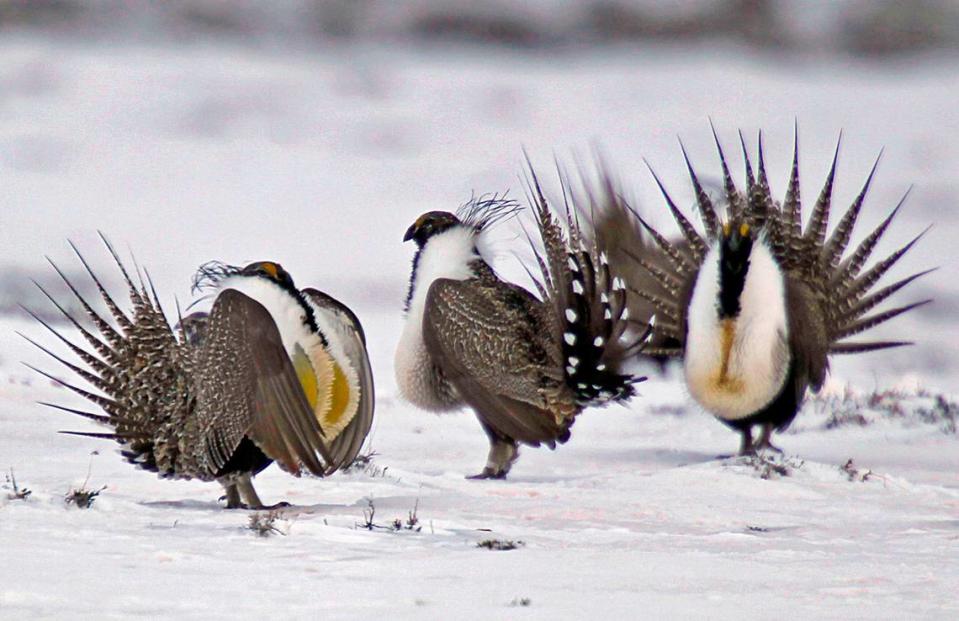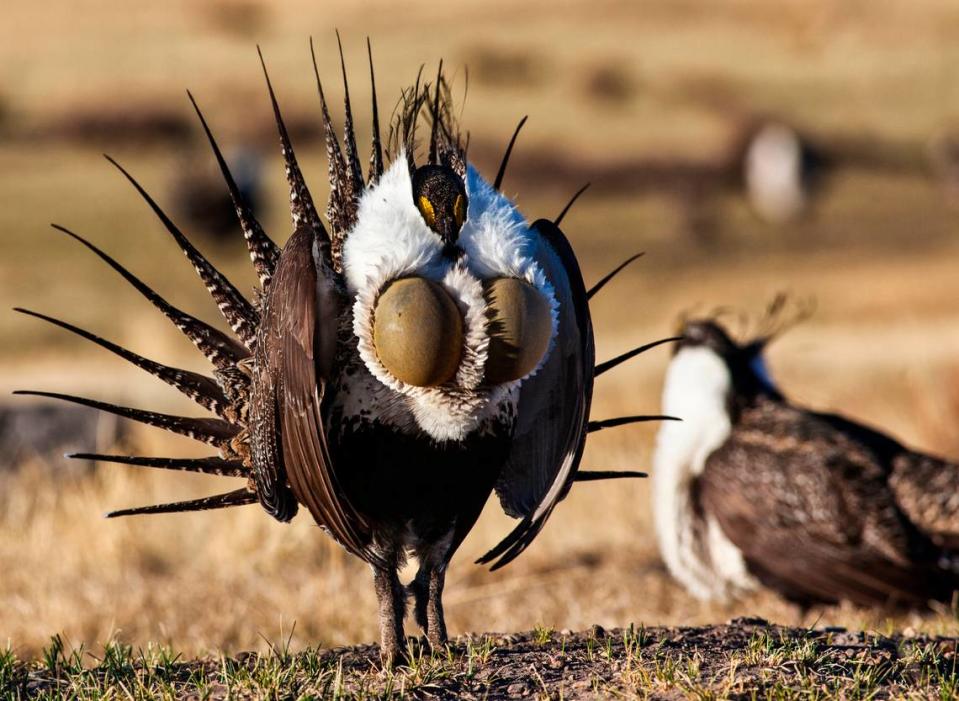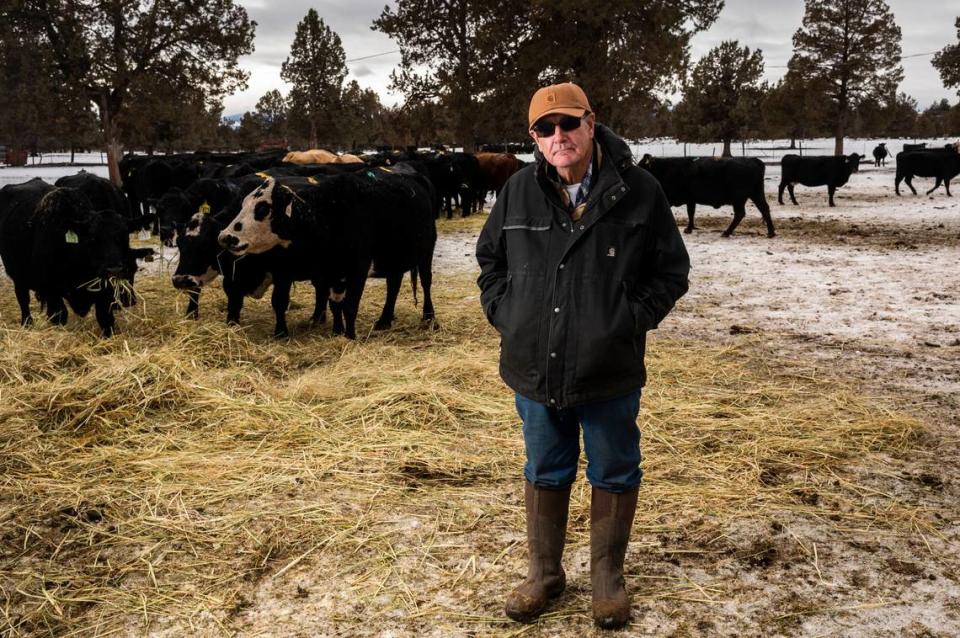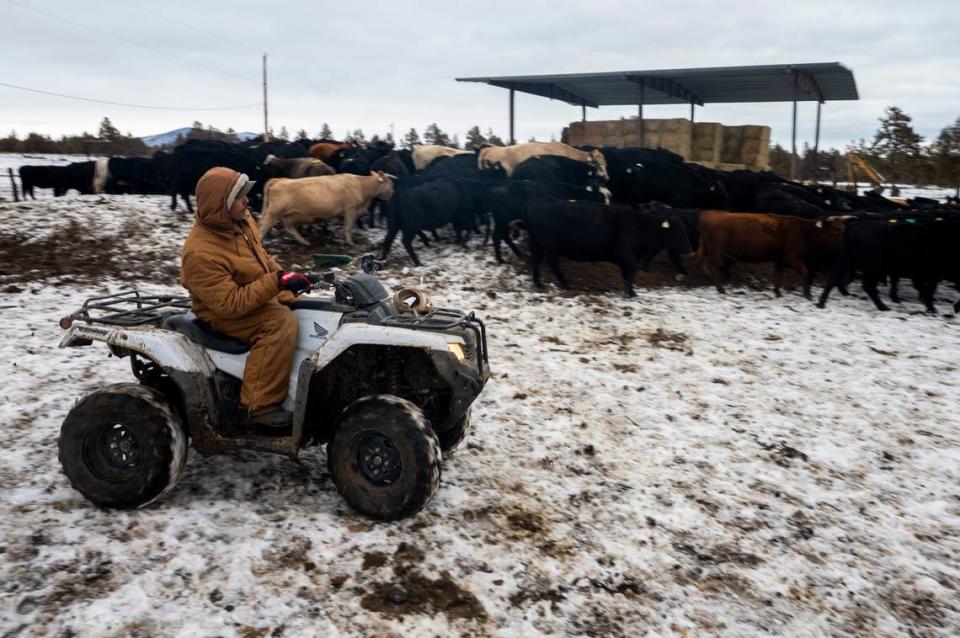A remarkable high-desert bird may go extinct in California. What must die to save it
It’s everywhere, this yellow plague. Grass between the lava rocks. Grass between the knee-high sagebrush clumps. Little shards of crispy grass stick in your socks after just a few steps.
This grass doesn’t belong here. It’s invasive, brought to North America decades ago and scattered across the landscape by livestock and machinery. Now, a remarkable high desert bird, the sage grouse, is at risk of disappearing forever from this rocky wildlife sanctuary — and elsewhere across the West — because of the unrelenting spread of this horrible grass.
All it takes is a spark to ignite catastrophe.
In the summer of 2019, a motorist’s tire blowout started a fire miles away from the Clear Lake National Wildlife Refuge on a Modoc County highway. The fire roared unnaturally fast and hot through the invasive grass, burning the last remaining nesting area for the sage grouse in this part of far Northern California.
The next spring, Chelsea Sink, an Oregon State University graduate student who studies the birds, walked through the charred skeletons of the sagebrush that these birds rely on for every stage of their lifecycle.
“In the moment, I was like, ‘It’s over,’ ” she said.
John Beckstrand, a biologist with the U.S. Fish and Wildlife Service, took me in late September behind the refuge’s locked gates so I could see just how bad things have gotten out here. The fire on the western edge of Clear Lake was just the latest burn. Two decades ago, another fire ripped through the refuge’s eastern edge.
Most of the sagebrush that burned still hasn’t grown back.
“It’s a microcosm of what’s going on in the West,” Beckstrand said.
Invasive grass and fires aren’t the only threat to the grouse. Development, overgrown forests and a warming climate have collided with bureaucratic vapor-lock, litigation and a political fight over livestock grazing and fossil fuels extraction in the West.
Even so, Beckstrand showed me something remarkable — a possible solution to the onslaught of invasive grasses that are the single largest risk to wiping out these birds and perpetually choking California’s air with out-of-control wildfires.
In one 100-acre patch of land, the nonnative grasses were dead, but native grasses and sagebrush were very much alive. This oasis wasn’t there by chance. It was there because of a specially formulated herbicide sprayed inside this critically sensitive habitat.
Just mentioning the words “pesticide” or “herbicide,” or Monsanto or Dow Chemical, and it’s often a full-stop for the state’s legions of committed environmentalists. This is the West, and California, where nothing comes easily.
But could this be the answer to save these sage grouse?
‘That’s where we learned to dance’
Each year in this quiet vastness, the grouse announce the end of the frigid high desert winters through the males’ springtime courtship dancing on their “lek” breeding grounds. They loudly pop the air sacks out from their snowy-white chest feathers and spread their elaborate tail fans to intimidate rivals and impress females.
“It’s just a remarkable thing,” said Christian Hagen, a grouse scientist at Oregon State University. “It’s like if you’ve ever gone and heard elk bugle. The first time you hear it or see it, it evokes something you just can’t describe.”
Before white settlement, the birds were an important food source for the tribes who shared their habitat, and the birds played a key role in their cultural and spiritual lives.
“That’s where we learned to dance,” said Perry Chocktoot, the culture and heritage director for the Klamath Tribes, the local federally recognized nation made up of the Klamath, Modoc and Yahooskin band of Northern Paiute Indians.
A few years ago, biologists counted only six male grouse dancing here on “The U” at Clear Lake, a 5,500-acre peninsula of rock and sagebrush surrounded by a 20,000-acre reservoir.
The U is the only known sage grouse breeding ground left of the 56 leks that were once spread across hundreds of square miles in Modoc and Siskiyou counties, the sage grouse’s western-most habitat in North America. As recently as 1970, there were close to 14,000 grouse in this portion of Modoc County alone.
Less than 1,900 remain statewide. Nationwide, between 200,000 and 500,000 sage grouse are on the American landscape.

Clear Lake was once the marshy headwaters of the Lost River, a 60-mile “closed basin” stream that snaked from the mountains of Modoc County through Klamath County, Ore. to Tule Lake in California where it dead-ended.
Early during the last century, the federal government built the dam that forms Clear Lake as part of the Klamath Project to irrigate farms. Clear Lake was designated a National Wildlife Refuge in 1911, but during World War II, the military commandeered the area to practice strafing attacks and bombing raids.
The local grouse, known as the Devil’s Garden population, managed to survive in this bombed, dammed and grazed landscape.
“There was a time that if someone mentioned observing or hunting sage grouse in the Golden State they were probably referring to the Devil’s Garden sage grouse population,” reads a 2010 report by the Clear Lake Sage Grouse Working Group. “Those days have long since passed.”
In the 1970s, biologists and bird hunters started noticing fewer birds across the region. Biologists found grouse on just nine leks. In 1982, the numbers got so bad that grouse hunting was closed in the area.
The altering of grouse habitats from 150 years of development and agriculture is undoubtedly contributing to the declines. But the most pressing threat stems from fire — thanks to that sea of yellow grass choking The U.

The grasses, which infest 100 million acres across the West, have dramatically altered the sagebrush ecosystem. They suck up what little moisture that falls, degrade the Great Basin soil, and choke out the native perennial bunchgrasses.
All that crispy fuel in the dry months causes fires to explode with an intensity that’s far more destructive than the fires that burned through the sagebrush from time to time for centuries after the last ice age.
“Fire used to be what kept the range open, you know, kept the trees in check and, now, wildfire is the biggest threat to sage grouse, really, because of those annual grasses,” Beckstrand, the federal biologist, told me as our shoes crunched through the grass choking The U.
The grasses were a mix of three types of “annuals,” meaning they germinate from seeds each spring: Medusahead, cheatgrass and Ventenata dubia. Medusahead and cheatgrass, native to Asia and Europe, began showing up in North America in the 1800s.
Ventenata, native to Africa, western Asia and southern Europe, arrived as recently as the 1950s.
Their clingy seeds stick to the fur of cattle and sheep, clothing and vehicles, allowing them to move quickly over much longer distances than the wind alone would carry them. Once they’re dislodged from their transports, the seeds germinate in dusty soils between the sagebrush plants and the bunchgrasses in these high desert plateaus.
When they dry out in the summers, medusahead and Ventenata contain particularly high levels of silica and have little nutritional value for grazers. Their pokey spines and shards can damage the mouths and throats of the animals that take a bite.
Not far from Clear Lake where wild horses graze in the Devil’s Garden in the Modoc National Forest, it’s common to see yellow clumps of Ventenata on the ground. That’s where the horses chomped off a bunch and then spit it out.
Sagebrush grows slowly — some plants may be more than a century old — and it doesn’t reseed quickly. After a burn, the invasive grasses and other non-native plants quickly swarm the burned areas.
Sagebrush seedlings are difficult and expensive to grow in farmed environments, so replanting after a burn is a major undertaking, especially considering the massive amount of acreage that has burned in recent years.
And when the sagebrush goes, so does the grouse.
Grouse use the bushes as camouflage to hide from predators while they’re nesting. The birds eat the bugs that live in the dirt around the brush.
In the winter, the grouse survive almost entirely on sagebrush leaves. Sagebrush has poor nutritional value and most animals can’t digest it. But sage grouse can. Their beaks are shaped to snip the leaves in just the perfect way to allow their digestive enzymes and gut bacteria to break down the plant. The birds’ intestines also grow longer in the winter months, helping them to digest the plant.
Because of these incredible evolutionary adaptations, sage grouse actually gain weight in the winter.
The 100-acre strip of dead grass at Clear Lake represented a last-ditch effort to save from fire all that’s left of the critically important sagebrush.
Could an herbicide save these birds?
The type of herbicide the agency used to create this small fire break on The U is called Esplanade, produced by Bayer, the huge multinational pharmaceutical and chemical firm that recently merged with Monsanto.
Guy Kyser, a weed specialist at UC Davis, said it’s shown promise in sagebrush habitats because it’s formulated to kill annual plants like non-native grasses while sparing the native perennials like sagebrush and bunchgrasses.
But its widespread use will require overcoming fear about spraying chemicals in wild places, particularly in environmentally conscious California.
“When you say ‘herbicide,’ ‘It’s Roundup; it’ll kill everything,’ Kyser said. “They don’t realize that there are selective herbicides that will leave the good plants but take out the bad plants when used correctly.”
“There isn’t enough money in the Treasury” to spray the herbicides to combat that yellow plague across the West, but it could restore critically important spots like The U and maybe bring these remarkable birds from the brink, said Hagen, the Oregon State scientist who plans on working with the U.S. Fish and Wildlife Service on Clear Lake to study the spraying.
“It’s a reeducation I think,” he said. “If we can demonstrate where it’s working, people might change their tune.”
Whether environmental groups would ever allow Esplanade to be used more widely on The U — and across the West — is another question.

The Center for Biological Diversity, one of the nation’s most litigious environmental groups, has already sued the Klamath Basin Refuge Complex, which manages Clear Lake, for allowing the use of pesticides at its sister refuges, Lower Klamath and Tule Lake.
Lori Ann Burd, the group’s environmental health director, said that the case was geared toward stopping farmers who grow crops on those refuges from using the chemicals — not because her organization has a blanket policy against using herbicides to help a species.
“There’s so much truly egregious use of truly egregious pesticides on national wildlife refuges that this isn’t something that we’ve focused on,” Hurd said of spraying Esplanade. “Or that we’ve come out to publicly oppose.”
That said, any widespread use of the herbicide would need to be extensively studied and a comprehensive management plan, she said.
Meanwhile, Paul Ruprecht, the Nevada-Oregon director of the Western Watersheds Project, said he wasn’t familiar with Esplanade, but his group generally opposes the use of herbicides on public lands.
To his organization, cattle are Enemy No. 1.
That’s why his group along with the Center for Biological Diversity have sued the U.S. Fish and Wildlife Service over allowing ranchers to graze cattle on Clear Lake.
“Instead of repeatedly treating invasive grasses on a national wildlife refuge with chemical herbicides, the agency should simply remove the biggest cause of invasive grass infestations in the first place, which is livestock grazing,” he said in an email.
Ranching family has deep ties to land
Among the co-defendants in the suit is Mike Byrne. For six generations, the Byrne family grazed their cattle on the Clear Lake refuge, before their land was condemned by the federal government so the reservoir could fill.
I met Mike Byrne and his son, Matt, on a frosty October morning inside their farmhouse, which sits just barely on the California side of the border near the small city of Malin, Ore. The Byrnes keep in their house a picture, dated 1872, of the U.S. Army camped on the field outside their front door during the Modoc War, the final conflict between settlers and the native peoples of this region.
The Byrne family says the government has severely curtailed access to their family grazing land over the decades.
“At one time out there, it was probably 3- or 4,000 head year-round that were grazing roughly the same area we do today, before the Forest Service, before the refuge,” Matt Byrne said. “And now that’s been changed to a much tighter managed system. And it’s half the numbers for half the year. So basically, a quarter of the grazing.”

In the late 1990s and early 2000s, environmental groups began petitioning the federal government to protect the grouse under the Endangered Species Act, and they kept the pressure on for the next decade and a half.
During that time, the Byrnes were among the ranchers working with the government to come up with a plan to save the grouse.
In 2015, the Obama administration announced that protecting the grouse nationally wasn’t warranted because agencies and private landowners had committed to regulatory protections and financial resources to ensure the bird’s survival.
The move put “tremendous funding into range conservation efforts across the West by multiple agencies, including states who have been putting significant parts of their overall budgets into sagebrush conservation,” said San Stiver, the sagebrush initiative coordinator with the Western Association of Fish and Wildlife Agencies.
Over the next four years, the Trump administration undermined those efforts to allow for more fossil fuels extraction in the West
“That plan was ripped apart by the Trump administration, I think for no other reason than it had Obama’s name on it,” said Bruce Babbitt, the former secretary of the Interior under President Bill Clinton.
Regardless of the political battles, the Byrnes say they’ve done their part to save the grouse. They’ve worked with biologists studying the birds, and they have contributed labor to the restoration efforts on The U, the surrounding national forests and on private lands.
For Mike Byrne, helping restore the birds’ habitat amounts to enlightened self-interest.
“If we moved the bird one way (toward local extinction), we’d probably go away,” he said. “So we’re doing positive work to help a species which we have no control over.”

Much of their efforts in Modoc County have revolved around removing thousands of junipers, the evergreen trees that are common on the edges of high deserts.
Juniper trees have over the past few decades increasingly encroached into America’s sagebrush steppes, including at Clear Lake.
They compete with other vegetation like sagebrush for water. They also provide ready perches for keen-eyed predatory birds like ravens to be able to scout for an easy meal of sage grouse eggs and hatchlings.
Scientists say the juniper encroachment is due primarily to a century of fire suppression in Western forests. The policy of trying to quickly extinguish every wildfire to protect timber stocks, rather than allowing fires to burn naturally, is a big reason why so many destructive fires have burned in California over the past few years.
Before settlers arrived and brought with them invasive grasses, the low-intensity fires that periodically swept through the forests kept the juniper in check. For decades, the federal government’s fire suppression policies allowed junipers to grow without limits.
The teams cutting thousands of the trees down across Modoc County are “mechanically doing what the fires used to do,” Matt Byrne said. “But there’s a limit to what you can do.”
Tree removal isn’t without its own controversies and bureaucratic hurdles. Environmental groups are furious at a Trump administration plan issued this month to bypass environmental reviews for juniper cutting in sagebrush habitats.
At the same time, some Native Americans find the juniper cutting problematic — leading to more bureaucratic delays to conduct heritage surveys.
“They’re cutting down old, old ancient junipers that Indian people may have made bows out of, you know?” said Chocktoot, the Klamath Tribes’ culture and heritage director.
‘It’s an absolute joke, to be just real blunt about it’
But how much is the Byrne family’s grazing actually part of the problem?
“When you’re looking at the grand scheme of what the grouse are facing today, cows are the least of my concern,” said Hagen, the Oregon State grouse researcher.
“When people say, ‘Take the cows off,’ it’s like telling somebody that has Stage 4 lung cancer to ‘Quit smoking, and ... your cancer is going to go away.’ I mean, it’s a joke. It’s an absolute joke, to be just real blunt about it.”
Stiver, the sagebrush initiative coordinator with the Western Association of Fish and Wildlife Agencies, said the various factions in these debates tend to focus on one particular solution to solve the problem.
“Everybody points their six-shooter in a direction but hardly ever point it back at them,” he said. “And oftentimes, they’re looking at a single bullet. And this is a very complex problem.”
The ever-present threat of lawsuits from the rival factions stalls attempts to try something new that may stop a species from going extinct. Just about every management change must go through an expensive and often years-long environmental review process.
If it contains anything even remotely controversial, the plan has to withstand multiple legal challenges before it’s carried out. Budge an inch from that plan and the agency will get sued again.
If the plan survives all that, there’s the daunting task of finding the funding to carry it out.
All this is why I’m not particularly optimistic about ever seeing the grouse in Modoc County bounce back. Too much sagebrush has already burned, and the expenses and legal and bureaucratic hurdles of using herbicides on a landscape-level scale are probably too daunting.
If not for human intervention, these birds on The U already would have disappeared.
In 2005, after just six male grouse were counted on the lek (they’re the easiest to count when they’re strutting during their mating dances), the federal government began transplanting birds from larger Oregon populations to bolster the Clear Lake refuge numbers. The females brought to the area are fitted with GPS-tracking backpacks so biologists can monitor their movements.
Despite more than 150 birds released on The U in the years since, only a few dozen remain.
Sink, the Oregon State grad student, and her colleagues counted 19 males on the lek this year, and they know there are at least six females in the area because of their GPS backpacks.
“There’s so much work to be done,” Sink told me. “And you get to the point where you’re like, ‘How can we ever do this?’ ”
“In my heart, I want there to be some secret lek we haven’t found,” she said. “It’s pretty dire straits. It would really require a huge effort from everyone involved to get them back on track. It’s hard for me to be positive about it.”
This reporting was supported by the Institute for Journalism & Natural Resources .


